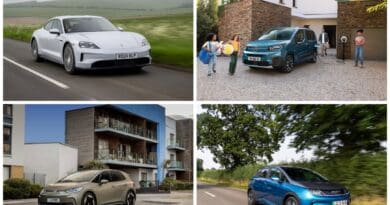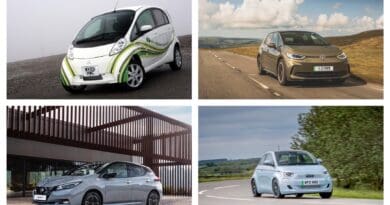Joining Polestar’s drive for sustainable leather with Bridge of Weir
The subject of leather in cars is a sometimes touchy one.
Long a symbol of a luxury specification, some manufacturers are shying away from it, with a few even vowing to go 100% leather-free as part of their drive towards more sustainable vehicles.
For a brand like Polestar, which puts such importance on its green credentials, ditching leather might seem like an easy choice. Especially with innovations in upholstery made from recycled plastics and textiles. But the performance EV brand still sees a place for it in the premium sector, as long as it’s made the right way.
Which is how I found myself driving a Polestar 2 from the brand’s new Glasgow retail ‘Space’ to the Bridge of Weir tannery in the Renfrewshire countryside.
Bridge of Weir’s association with the car industry is almost as old as the motor car itself. In 1911, its founder Arthur Muirhead sat down with Henry Ford and, if the stories are to be believed, thrashed out a deal over whisky and cigars that would see the Scottish firm supply leather upholstery for the new Model T.
Since then, it’s become the go-to leather maker for everyone from Ford, BMW and Land Rover to Aston Martin, Rolls-Royce and, of course, Polestar. The brand prides itself on not only being the purveyor of the finest automotive leather but also being at the cutting edge of production, environmental awareness and sustainability, making it the ideal supplier to the Swedish EV maker.
Last year Bridge of Weir opened a new £14m ‘super-tannery’ which has cut its energy and water use by 82% and 42% respectively and where it is developing and introducing new processes to make its products more sustainable.

The new site represents a massive investment for this relatively small business but sales director and great-grandson of Arthur, James Muirhead, says it was done to ensure the brand could meet the increasingly high standards set by clients like Polestar.
“The auto industry is fast moving, complex and highly demanding,” he told me. “It takes a different mindset to other areas of production and we’re continuously investing in ways to optimise and improve our productivity, quality and sustainability.”
That ranges from how it sources the energy that powers the factory to the chemicals used in the tanning process. But the first and arguably most sustainable element of the whole process – and one that Muirhead is at pains to emphasise – is that all Bridge of Weir’s hides are already a byproduct. All its hides come from animals slaughtered for the food industry and it takes around 30% of all UK hides which would otherwise go to landfill.
Unlike some leather makers who source their raw materials from global markets, 98% of the firm’s hides come from the UK and Ireland, with nearly half coming from within Scotland.
On average, Muirhead tells me, the hides travel less than 60 miles from supplier to tannery. And with guaranteed 100% traceability Bridge of Weir can track every piece of leather back to the farm where the animal was reared.

Before the rawhide becomes a beautifully finished seat or dashboard, there’s a huge number of processes for it to go through, not least the initial tanning. This is potentially the most wasteful and harmful stage as a 45kg hide is stripped down to the final 4kg product using a variety of chemicals.
These chemicals have, historically, been packed with harmful heavy metals but among the latest innovations from Bridge of Weir are two new methods – Biotan and Freetan – which aim to clean up the process. The technologies help remove fossil fuel, oil-derived components and heavy metals from the process to make it less polluting and create a more biodegradable product. Bridge of Weir’s ultimate ambition is to have an all-biological tanning process and fully compostable finished product.
In combination with cleaner tanning chemicals, a zero waste policy sees every off-cut and byproduct reused. With a finished hide weighing just 11% of the original skin, there’s a lot of potential waste but the unwanted elements find their way into everything from energy to the pharmaceutical industry.
Half of the biological waste is repurposed on-site to power the tannery’s thermal energy system while fat from the hides is rendered down into valuable biodiesel. Other elements are processed for use in the food industry – enjoy that protein bar – and cosmetics, where collagen has many uses.
The commitment to reducing its impact even extends to the water used in the production process. While the site gets through a million litres of water a day – half the industry standard – it is sourced from the tannery’s own reservoir and 40% is filtered and used again in the production process. And, as you’d expect, all its energy comes from renewable sources.

While we were spared the noise and smells of the tanning facility itself, we did get to see where the hides are prepared, coloured and finished to each manufacturer’s specific requirements. Walking around the factory I saw the evidence of the investment, from massive dyeing drums and drying machines to a state-of-the-art quality testing lab where every batch is checked for colour retention, durability and even smell.
Among recent innovations are a 3D printing system that incorporates patterns into the leather part-way through production rather than sticking a design to the finished hide. This is showcased in the new Polestar 3, where the leather’s carbon footprint is proudly displayed on the seat back.
That overall carbon footprint is another key element for Bridge of Weir, which has cut its CO2 emissions from 10.9kg per hide in 2003 to 1.3kg in 2021. It aims for all its leather to be zero carbon by 2025 without any recourse to offsetting schemes.

While some car makers are improving the sustainability of their models by using reclaimed plastic in seat and carpet fabrics other firms are exploring “leather” made from a variety of organic substances – pineapple leather, anyone? But Muirhead believes that there will always be a place for high-end genuine leather.
“People deserve a choice regarding what type of material goes into their vehicles,” he says. “It’s just a matter of being able to compare materials both in terms of sustainability and durability.
“Commodity leather might be replaced by alternatives but true sustainable leather will maintain its place.”

Polestar certainly agrees and while it offers wool and animal-free upholstery in its cars, it is also committed to giving customers the option of a sustainably produced leather interior.
Fredrika Klaren, head of sustainability at Polestar said: “We were really happy to be able to work with Bridge of Weir around the leather in Polestar 3, which is an amazing company in terms of sustainability ambition.
At Polestar, we believe in more sustainable choices. That’s why we offer our customers a choice of traceable, chrome-free, and animal welfare secured Nappa leather, bio-attributed MicroTech vinyl, or animal welfare-certified wool for their Polestar 3 upholstery.
“Only the best materials, with transparent origins, for our customers.”
With client backing like that and a commitment to ever greener production techniques, it seems that we’ll still be hearing car makers boasting of their Bridge of Weir interiors for a long time to come.






